Project-based language learning among university students
Török Judit & Kétyi András
Budapest Business School, Hungary
torok.judit@uni-bge.hu
ketyi.andras@uni-bge.hu
Abstract
Our university research group has been working on the implementation of the methodology of Project-Based Language Learning (PBLL) into the German business language courses, and action research was conducted as well. Our sample was university students learning German business language either as a first (n=65) or as a second foreign language (n=59). Our hypotheses were as follows: the problem-solving skills of the students will improve in the authentic language learning situations (H1); the students become more motivated in language learning (H2).
Keywords: project-based learning, motivation, problem-solving, second language acquisition
Project-Based Language Learning
Regarding the modern business language-pedagogy, project-oriented learning is an important method (Surkamp 2017). Projects, which are integrated into the language teaching process help to create activity frames and they initiate authentic speaking and conversation situations (Moss and Van Duzer 1998). Students use authentic sources, the teacher is a facilitator, aims are defined explicitly, the learning has a cooperative character, and the essential skills appear during the project phases (Thomas 2000).
Research methods and questions
We planned our research with pre- and post-measurement, pre-measurement was conducted at the beginning of the first semester, the post-measurement at the end of the second semester. We involved the entire year learning business German (1. figure, 2. figure).
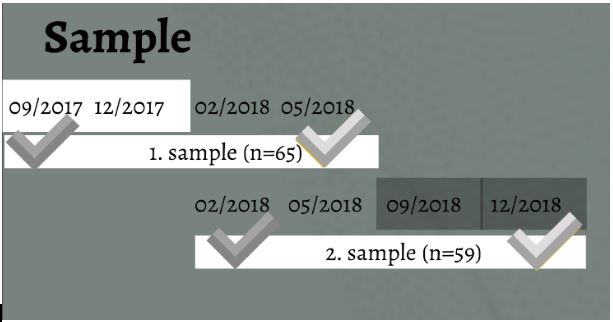
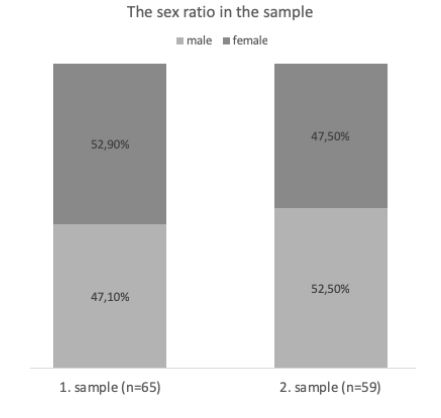
Hypothesis, research tools
Our research questions were as follows:
- The problem solving of students can be developed in authentic language situations. (H1)Students will be more motivated during language teaching. (H2)
- The problem solving of students can be developed in authentic language situations. (H1)Students will be more motivated during language teaching. (H2)
Our measurement tools are listed in the table below (1. table)
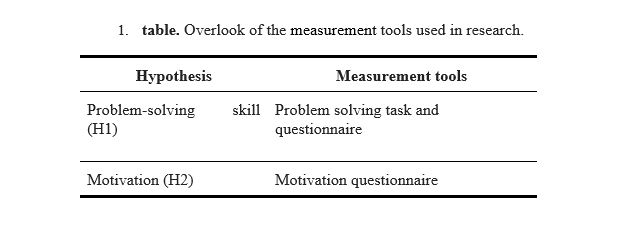
Results
Problem-solving
With the first sample (n=58) we measured a significant difference (p<0.001) by the problem-solving task in the first and second semester as well (3. figure). At the pre-measurement, the problem-solving process lasted in average 15.35, in the post-measurement 16.98 minutes.
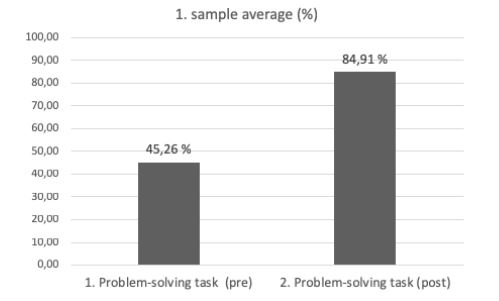
With the second sample (n=50) in the problem solving we did not measure a significant difference (4. figure), but in the time we did (p<0,001). While students needed in the first case in average 18.64 minutes, their used time was at the post-measurement only 14.79 minutes.
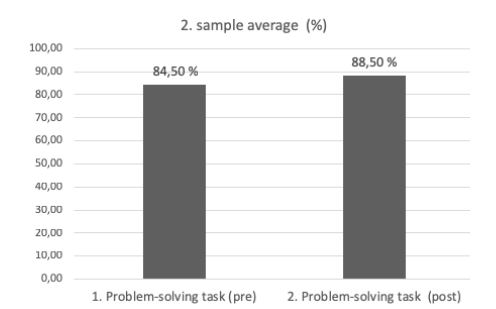
Comparing these two samples we could see a significant difference in the results of the pre-measurement, but in the post-measurement, we could not (5. figure). The time required to filling showed a significant difference (p<0,001) during the pre-measurement: the first sample needed for problem-solving in average 15.13 minutes, the second sample 18.94 minutes. By the post-measurement time did not show a significant difference: the first sample worked for 16.77 minutes while the second sample for 14.79 minutes.
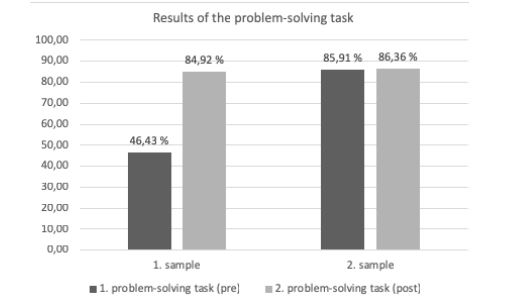
In the questionnaire for the problem-solving task, we searched which problems are in general solved with the help of the internet by students, furthermore, if the problem-solving task meant any problem for them. We elaborated the results with content analysis. By our research, we compared the answers of both samples (German as 1. or 2. language). The most frequented answers of both samples were “Collecting of information”, “Problems related to school tasks” and “Solving of any problem” (6. figure).
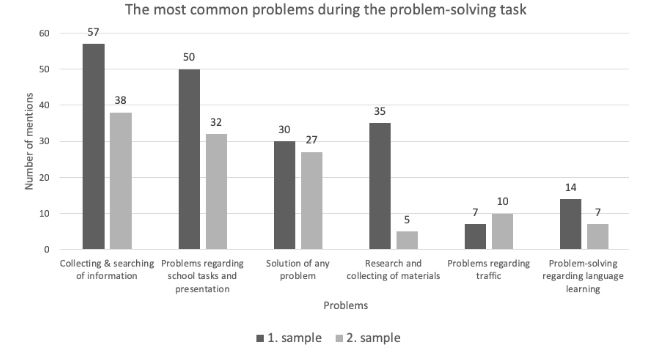
The fourth most frequented problem was different: “Research work, collecting of material” versus “Problems related to the traffic”, however, both samples mentioned the problem-solving related to language knowledge (using of a dictionary, translation).
Regarding the problem-solving task, there is a significant difference between the two samples (7. figure). While 68% of the first sample did not have any difficulties with problem-solving, 29% of the second sample stated the same. By the result of the problem solving we did not explore any difference. By the problems related to using of language we could see a difference: while this the most frequented problem of the second sample is (29%), seems this problem in the answer of the first sample marginal (3%).
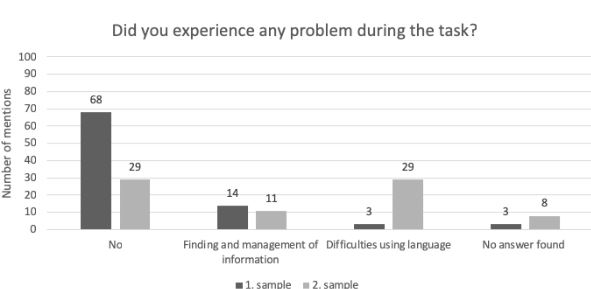
By the problem-solving task, we measured a significant difference only with the first sample. Comparing the two samples, we explored a significant difference only by the pre-measurement. Our hypothesis, such as PBLL develops problem-solving of students, could be proved only in the case of one sample. The results of the first sample (students at the beginning of their studies) were feeble by the pre-measurement.
Motivation
Among the students who participated in both measurements (n=58) we did not measure any significant difference at the pre- and post-measurement. (1-worst value, 5-best value) (8. figure).
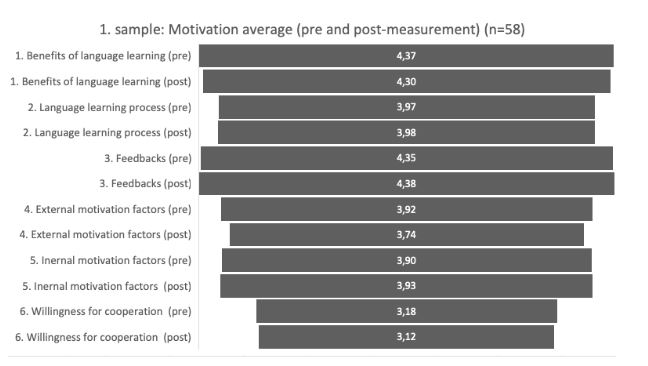
At the 2. sample we measured significant difference at the internal motivation values (9. figure, 5. category) (p<0.005) so that the internal motivation values of students in the second sample have decreased.
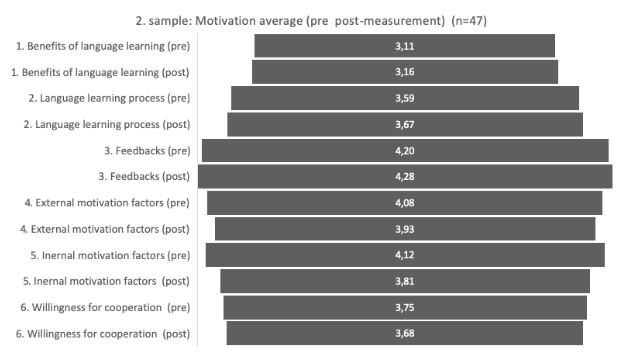
Comparing two samples we found significant difference (p<0.001) in favour of the first sample in the pre-measurement in two categories (Language learning benefits (1.) and Language learning process (2.). On the contrary, we measured in the students’ cooperation affinity (6.) significant difference (p<0.001) in favour of the second sample (10. figure).
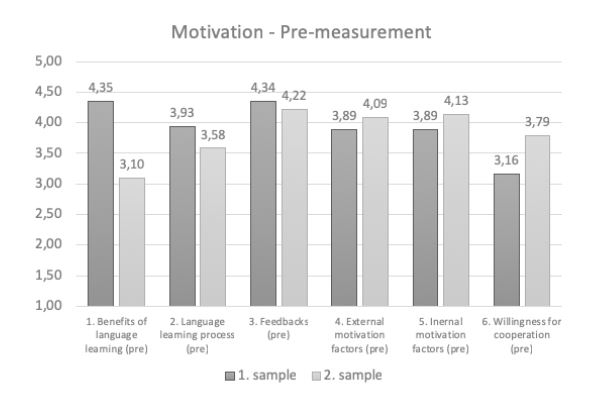
In the post-measurement we found significant difference (p<0.001) in favour of the first sample only at Language learning benefits (1.) and in favour of the second sample at students’ cooperation affinity (6.) (11. figure).
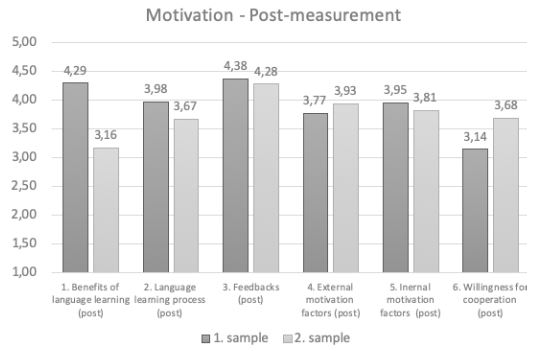
Regarding the motivation results, it could be possible that the students in the second sample motivate the external factors like peer and teacher feedback, grades more than the internal factors. However, it could be conceivable as well that the project work required so much time that the participants did not want to keep oneself busy with language learning after the lessons in their spare time. The hypothesis that students will be more motivated during language lessons we have to reject.
Discussion
To give an obvious answer to the hypotheses further research of a third sample may help, which has been conducted recently (September 2018-December 2019). We agree with Thomas’s (2000) statement: the impact of PBLL may grow if it will be applied in the entire institution, which can be for further researches in the future.
References
Campbell, S. A. (2012) The Phenomenological Study of ESL Students in a Project-based Learning Environment. International Journal of Interdisciplinary Social Sciences. 6/11. pp. 139-152.
Hafner, CH. A., Li, D. C. S. & Miller, L. (2015) Language Choice Among Peers in Project-Based Learning: A Hong Kong Case Study of English Language Learners’ Plurilingual Practices in Out-of-Class Computer-Mediated Communication. Canadian Modern Language Review. 71/4. pp. 441-470.
Kelsen, B. (2018) Target language use and performance in Project-Based Language Learning (PBLL). The Journal of Asia TEFL 15/1, Spring 2018. pp. 199-207.
McDouall, A. & Seidel, M. (2017) Blended Learning + : Combining Project-based Language Teaching with the Team Protocol Method. https://www.academia.edu/32911871/Blended_Learning_Combining_Project-based_Language_Teaching_with_the_Team_Protocol_Method
Moss, D. & Van Duzer, C. (1998) Project-Based Learning for Adult English Language Learners. ERIC Digest. https://www.ericdigests.org/1999-4/project.htm
Rummler, M. (ed) (2012): Innovative Lehrformen: Projektarbeit in der Hochschule. Weinheim – Basel, Beltz Verlag.
Surkamp, C. (2017) Metzler Lexikon Fremdsprachendidaktik: Ansätze – Methoden – Grundbegriffe. 2., akt. und erw. Aufl. Stuttgart, J.B. Metzler Verlag.
Thomas, J. W. (2000) A Review Of Research On Project-Based Learning. http://www.bobpearlman.org/BestPractices/PBL_Research.pdf